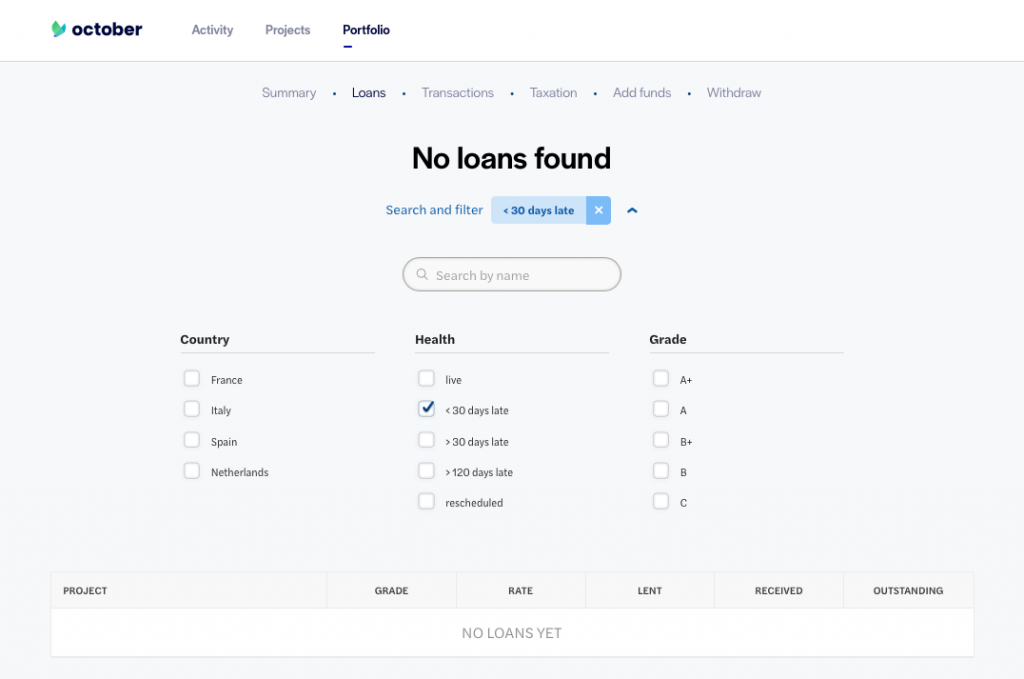On October we create a link between companies who are looking for a loan and private and institutional lenders. Lending to companies allows for a fair return on savings. However, lending to companies is not without risk.
With crowdlending, there is the risk that the company to which a lender has lent, is not able to repay the loan. In this case (part of) the capital invested can be lost.
Why would a company not repay a loan?
The reason is pretty straightforward: companies are exposed to business risk. For example, there is the risk that a buyer does not pay for an order on time, or that a flood ruins a company’s stock. These events have negative consequences and can affect the ability of the company to repay. Throughout the lifetime of a company there is this risk. No one can predict if a company that got a loan, will encounter liquidity issues or even bankruptcy because of these unpredictable events.
If a company works together with October and discloses their situation on time, debt rescheduling can be an outcome. With debt rescheduling the company gets some room to overcome temporary financial problems. For example by lowering the repayment amounts for a period of 3 months, or extending the tenor of the loan. It temporarily reduces the burden of repayments on the cashflow. You can read more about debt rescheduling in this tutorial.
When debt rescheduling does not work as planned, or it is too late to start rescheduling, it can be that a company will never repay its debt. In this case we are talking about a default.

What do we do in case of a default?
In case of a default, October takes charge of the recovery process on behalf of all the lenders and contacts the company that is not repaying. We will try to understand the situation the company is in and attempt to come to a solution as soon as possible.
From then on, there are three scenarios:
- The company regularises its situation immediate and starts repaying as planned.
If after these 7 days the company does not regularise its situation, October will transfer the debt recovery to a recovery partner, who is specialised in recovery of funds. - The partner will start amicable recovery, during which we attempt to come to a solution together with the company. The objective is to reach a bilateral agreement. The tone of amicable recovery is positive and actions include e-mails, telephone calls, formal notices, etc.
- If amicable recovery does not work, or there is no reason/opportunity to start with amicable recovery in the first place, our recovery partner will start judicial recovery. The partner will take the company to court and will try to recover the amount with the help of a judge.
The team of the country in which the loan is originated is responsible for recovering the debt. So, if a French loan defaults, the French October team is responsible for recovering the debt, also for non-French lenders.
How do lenders stay informed?
Every month, when the repayments are done, lenders will receive an e-mail with a warning that one, or more, of their loans have not been repaid as planned. The e-mail also includes instructions how to consult recovery actions.
There’s a filter on the loan page of an October account, that allows to filter on the status of a loan and keep track of payments. That way, it is easy to filter the bad loans, from the good ones.
The loans that do not repay as planned are accompanied with a link to a page on which recovery actions are summarised. This page is updated every month and forms the source of information on recovery.

How do defaults affect lenders?
A default affects the profitability of a portfolio and is reflected in a lower internal rate of return (IRR). Whenever there is a delay in repayments, October applies a provision on the outstanding capital. It reflects an estimate of the potential loss of the outstanding capital. The provision is increased while it takes longer for a company to initiate repayments again. In other words, the longer it takes for a company to start repaying again, the smaller the chance that repayments will resume.
The following provisions apply:
- Loans less than 30 days late and restructured loans: 40% provision.
- Loans between 30 and 120 days late: 80% provision.
- Loans more than 120 days late: 100% provision.
The system of provisions is created to provide lenders with a more realistic view of their loan portfolio at any time. Consult the complete tutorial.